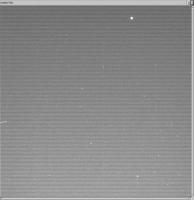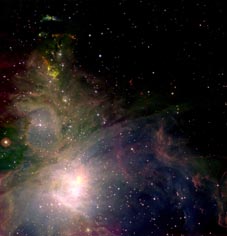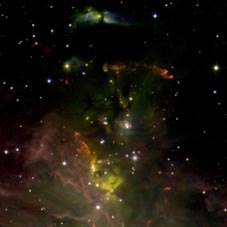by Paul Gilster | Dec 27, 2004 | Outer Solar System
The Huygens probe, captured in the photograph below as it departs from the Cassini Saturn orbiter, is now on course for its January 14th descent into Titan’s atmosphere. Look for the probe in the upper right quadrant of the image. Huygens’ separation from Cassini was achieved by firing explosive bolts; the probe was then pushed away by springs and rollers at roughly one foot per second.
 Image: The Cassini spacecraft snapped this image of the European Space Agency’s Huygens probe about 12 hours after its release from the orbiter. The probe successfully detached from Cassini on Dec. 24, 2004, and is on course for its January 14 encounter with Titan. Credit: NASA/JPL.
Image: The Cassini spacecraft snapped this image of the European Space Agency’s Huygens probe about 12 hours after its release from the orbiter. The probe successfully detached from Cassini on Dec. 24, 2004, and is on course for its January 14 encounter with Titan. Credit: NASA/JPL.
The journey to Titan’s surface should be quite a ride. According to this European Space Agency release, the probe will enter the atmosphere on Titan’s day side over its southern hemisphere. After the main parachute deploys, the probe will extend its instrument booms and begin collecting data about the moon’s atmosphere. The descent is expected to take fully 2 1/2 hours, with the probe relaying its data to the Cassini orbiter, which will then be flying over Titan at about 60,000 kilometers (37,000 miles). Once on the surface, assuming it survives the impact, Huygens may be able to send data to Cassini for as long as the orbiter is visible over the horizon at the landing site, a maximum time of a little over two hours. Cassini will transmit whatever it receives from the surface to the Deep Space Network and on to the European Space Agency’s operations complex in Darmstadt, Germany.
Ponder the distances involved for routing such data: Cassini’s signal confirming the Huygens separation took 68 minutes to make the journey from Saturn-space to Earth. Targets like Neptune will require correspondingly longer round-trip times, making spacecraft automation the key to our exploration of the outer planets. Ever more sophisticated robotic systems will be needed as we push past the ‘ice giant’ planets and head for the Kuiper Belt. At 4.3 light years, Centauri A and B will require a level of spacecraft automation that includes software that can evolve to meet mission demands and components that are capable of extensive re-design and self-replication.
Today the Cassini orbiter will change course to avoid following Huygens into Titan’s atmosphere, placing it on the right trajectory for optimal communications during the Huygens descent.
by Paul Gilster | Dec 25, 2004 | Culture and Society
Huygens is now safely on its way. More on this, and on Cassini’s post-separation course correction, next week. Until then, best wishes for the holidays, along with a thought from Arthur C. Clarke’s Interplanetary Flight: An Introduction to Astronautics (London: Temple Press Limited, 1960):
There is no way back into the past; the choice, as Wells once said, is the universe–or nothing. Though men and civilizations may yearn for rest, for the dream of the lotus-eaters, that is a desire that merges imperceptibly into death. The challenge of the great spaces between the worlds is a stupendous one; but if we fail to meet it, the story of our race will be drawing to its close.
by Paul Gilster | Dec 24, 2004 | Outer Solar System
The Huygens probe separation from the Cassini Saturn orbiter is scheduled to occur late this evening; according to this JPL press release, NASA expects a confirmation of the maneuver around 11 PM EST. The probe, which has been attached to Cassini for the seven-year trip to Saturn, has remained in sleep mode except for periodic ‘awakenings’ every six months to test its instruments. This evening, Huygens will be pushed away from the orbiter by tension-loaded springs and will begin its solo journey toward Titan, which it is expected to reach on January 14.
Both Huygens and Cassini are at this point on an impact trajectory with Titan, to ensure the accuracy of the probe’s arrival at the moon. On December 27, Cassini will change its course, putting it into proper position for radio communications during the probe’s descent.
The best source for Huygens information is either ESA’s Cassini-Huygens page or NASA’s Cassini page. The Cassini imaging team page is also well worth checking.
 While we’re waiting for the Huygens/Cassini separation, here’s a recent image of Dione.
While we’re waiting for the Huygens/Cassini separation, here’s a recent image of Dione.
Image: Saturn’s cratered moon Dione displays a large impact basin near its south pole in this Cassini spacecraft image. The topographic features that extend radially away from the basin could be secondary craters or tectonic grooves related to the impact. Dione is 1,118 kilometers (695 miles) across.
This view shows principally the leading hemisphere of Dione. The image was taken in visible light with the Cassini spacecraft narrow angle camera on Nov. 2, 2004, at a distance of 2.1 million kilometers (1.3 million miles) from Dione and at a Sun-Dione-spacecraft, or phase, angle of 100 degrees. North is up. The image scale is 13 kilometers (8 miles) per pixel. The image has been magnified by a factor of two and contrast enhanced to aid visibility of surface features. Image and caption credit: NASA/JPL/Space Science Institute.
by Paul Gilster | Dec 24, 2004 | Exoplanetary Science
Diana Valencia, a graduate student at Harvard, has been working with professor of geophysics Richard O’Connell in a study of the possible internal structure of large terrestrial planets around other stars. Their presentation “Internal Structure and Scaling Laws of Massive Terrestrial Planets” was given at the American Geophysical Union’s fall meeting. From the abstract: “The focus of this study is to calculate the internal structure of massive terrestrial planets starting from the knowledge acquired on the Earth and other solar system planets. With the use of equations of state for the Earth and physical laws we obtain radial structure profiles of mass, pressure and density, including all major phase changes for massive Earth-like planets.”
Why is this work important? Because the first mission likely to detect a terrestrial-type planet is Kepler, scheduled for launch in 2006. The spacecraft will attempt to detect such planets by watching for their transit across a distant stellar disk. And it’s clear that the first planets we’ll find using its methods will be massive objects with tight orbits around their parent star. Creating a model for the development and structure of such worlds will be a significant step in understanding what we’re seeing when the first Kepler results come in.
by Paul Gilster | Dec 23, 2004 | Deep Sky Astronomy & Telescopes
The UK’s new Wide Field Camera (WFCAM) has just begun operations at the United Kingdom Infrared Telescope site in Hawaii. WFCAM is designed to survey huge swathes of the sky at infrared (heat radiation) wavelengths, and should be able to work with deep sky objects as well as close brown dwarfs and other stars that, although relatively nearby, may have eluded detection.
 The ‘survey’ part of its job description means WFCAM is designed for a large field of view; no other infrared camera now operating can equal its range. The early results are spectacular. The two images shown here are among the earliest made by WFCAM. They focus on the area of intense star formation in the constellation Orion, some 1500 light years from Earth. To give you an idea of this telescope’s range, the full images it made of this region are 3600 times larger than Hubble’s infrared camera. By varying the type of infrared filters, the new camera shows thousands of young stars that would ordinarily be hidden by gas and dust at the wavelengths of visible light. Be sure to click on each image for higher resolution versions.
The ‘survey’ part of its job description means WFCAM is designed for a large field of view; no other infrared camera now operating can equal its range. The early results are spectacular. The two images shown here are among the earliest made by WFCAM. They focus on the area of intense star formation in the constellation Orion, some 1500 light years from Earth. To give you an idea of this telescope’s range, the full images it made of this region are 3600 times larger than Hubble’s infrared camera. By varying the type of infrared filters, the new camera shows thousands of young stars that would ordinarily be hidden by gas and dust at the wavelengths of visible light. Be sure to click on each image for higher resolution versions.
Image: Central region of the full tile, showing dramatic clouds of gas and dust illuminated by stars in the southern half of the Orion nebula. This is an image at three infrared wavelengths (red represents narrow-band emission from molecular hydrogen gas at 2.12 microns, green represents K-band emission at 2.2 microns, and blue represents J-band emission at 1.25 microns). The region is 11 light years across.
Talk about data glut: the four detector arrays that WFCAM uses create image tiles of 250 million pixels each. A single night of scanning will produce over 200 gigabytes of data. Centauri Dreams has commented before about the data deluge in astronomy; we need far better tools not so much for acquiring data as for mining it, which is why the developing idea of ‘virtual observatories’ that can combine these huge repositories to do meaningful science is taking hold. We’ll look at the concept again soon with an upcoming story on the new Virtual Solar Observatory, which combines fifty different data archives.
 Centauri Dreams‘ take: It seems possible that what we call the nearest star — the Alpha Centauri triple star system — is in fact only one of many nearby stars. M-class red dwarfs can be hard to spot. Indeed, the idea that there is a companion star to our Sun, perhaps a brown dwarf, has never been fully discounted. Dubbed ‘Nemesis’ because of the theory that its periodic approaches might disturb the Oort Cloud and result in species extinction events on Earth, the object had a brief but sensational history in the press, although no observational evidence for its existence has ever been found.
Centauri Dreams‘ take: It seems possible that what we call the nearest star — the Alpha Centauri triple star system — is in fact only one of many nearby stars. M-class red dwarfs can be hard to spot. Indeed, the idea that there is a companion star to our Sun, perhaps a brown dwarf, has never been fully discounted. Dubbed ‘Nemesis’ because of the theory that its periodic approaches might disturb the Oort Cloud and result in species extinction events on Earth, the object had a brief but sensational history in the press, although no observational evidence for its existence has ever been found.
Image: Zoomed image of part of the central region showing the full detail available from WFCAM. This is an image at three infrared wavelengths (red represents narrow-band emission from molecular hydrogen gas at 2.12 microns, green represents K-band emission at 2.2 microns, and blue represents J-band emission at 1.25 microns). The region is 3.6 light years across.
If it did exist, cameras like WFCAM would make searching for Nemesis much more effective. More likely than a Nemesis find, though, would be the discovery of nearby stars like the red dwarf SO25300.5+165258. First observed in 2003, it is only 7.8 light years away, making it the third closest to the Sun (after the Centauri system and Barnard’s Star). The suspicion here is that there are many more close objects, including some less distant than Alpha Centauri.
Image Credit: Joint Astronomy Centre. Data processing by Dr Chris Davis and Dr Watson Varricatt.
 Image: The Cassini spacecraft snapped this image of the European Space Agency’s Huygens probe about 12 hours after its release from the orbiter. The probe successfully detached from Cassini on Dec. 24, 2004, and is on course for its January 14 encounter with Titan. Credit: NASA/JPL.
Image: The Cassini spacecraft snapped this image of the European Space Agency’s Huygens probe about 12 hours after its release from the orbiter. The probe successfully detached from Cassini on Dec. 24, 2004, and is on course for its January 14 encounter with Titan. Credit: NASA/JPL. While we’re waiting for the Huygens/Cassini separation, here’s a recent image of Dione.
While we’re waiting for the Huygens/Cassini separation, here’s a recent image of Dione. The ‘survey’ part of its job description means WFCAM is designed for a large field of view; no other infrared camera now operating can equal its range. The early results are spectacular. The two images shown here are among the earliest made by WFCAM. They focus on the area of intense star formation in the constellation Orion, some 1500 light years from Earth. To give you an idea of this telescope’s range, the full images it made of this region are 3600 times larger than Hubble’s infrared camera. By varying the type of infrared filters, the new camera shows thousands of young stars that would ordinarily be hidden by gas and dust at the wavelengths of visible light. Be sure to click on each image for higher resolution versions.
The ‘survey’ part of its job description means WFCAM is designed for a large field of view; no other infrared camera now operating can equal its range. The early results are spectacular. The two images shown here are among the earliest made by WFCAM. They focus on the area of intense star formation in the constellation Orion, some 1500 light years from Earth. To give you an idea of this telescope’s range, the full images it made of this region are 3600 times larger than Hubble’s infrared camera. By varying the type of infrared filters, the new camera shows thousands of young stars that would ordinarily be hidden by gas and dust at the wavelengths of visible light. Be sure to click on each image for higher resolution versions. Centauri Dreams‘ take: It seems possible that what we call the nearest star — the Alpha Centauri triple star system — is in fact only one of many nearby stars. M-class red dwarfs can be hard to spot. Indeed, the idea that there is a companion star to our Sun, perhaps a brown dwarf, has never been fully discounted. Dubbed ‘Nemesis’ because of the theory that its periodic approaches might disturb the Oort Cloud and result in species extinction events on Earth, the object had a brief but sensational history in the press, although no observational evidence for its existence has ever been found.
Centauri Dreams‘ take: It seems possible that what we call the nearest star — the Alpha Centauri triple star system — is in fact only one of many nearby stars. M-class red dwarfs can be hard to spot. Indeed, the idea that there is a companion star to our Sun, perhaps a brown dwarf, has never been fully discounted. Dubbed ‘Nemesis’ because of the theory that its periodic approaches might disturb the Oort Cloud and result in species extinction events on Earth, the object had a brief but sensational history in the press, although no observational evidence for its existence has ever been found.
